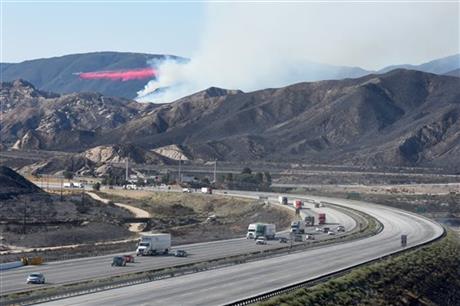- California Assembly OKs highest minimum wage in nation
- S. Korea unveils first graphic cigarette warnings
- US joins with South Korea, Japan in bid to deter North Korea
- LPGA golfer Chun In-gee finally back in action
- S. Korea won’t be top seed in final World Cup qualification round
- US men’s soccer misses 2nd straight Olympics
- US back on track in qualifying with 4-0 win over Guatemala
- High-intensity workout injuries spawn cottage industry
- CDC expands range of Zika mosquitoes into parts of Northeast
- Who knew? ‘The Walking Dead’ is helping families connect
Firefighters attack huge California wildfire by air, ground
SAN BERNARDINO, Calif. (AP) — Air tankers bombarded rugged slopes with fire retardant Thursday and a squadron of helicopters dropped load after load of water to corral a destructive wildfire threatening mountain homes 60 miles east of Los Angeles.
On the ground, firefighters and bulldozers worked to protect the ski town of Wrightwood and other areas high in the San Gabriel Mountains.
Authorities estimated that only half the 4,500 residents of Wrightwood heeded evacuation orders.
After five years of drought, California’s wildlands have seen a continuous streak of destructive and sometimes deadly fires this year.
The dry vegetation is like firewood, said fire information officer Sean Collins.
“It burns that much quicker, that much hotter. The rate of travel is extremely fast,” he said.
Fire officials indicated there were significant property losses but had yet to release a tally, leaving those who fled waiting to find out whether their homes were still standing.
Steve Boyd, 67, fled Wednesday with his wife from the mountain community of Lytle Creek. The former volunteer firefighter recalled staying behind during a destructive 2003 wildfire but didn’t regret leaving this time.
“It’s just stuff,” he said of his possessions.
Firefighters worked through the night to defend Lytle Creek.
“They made numerous saves,” fire information officer Bob Poole said.
Boyd had a stern warning for those who chose not to heed evacuation orders.
“A garden hose is not going to help,” he said.
The fire unleashed its initial fury on a semi-rural landscape dotted with small ranches and homes in Cajon Pass and on the edge of the Mojave Desert before climbing the mountains.
Travel was returning to normal Thursday in the pass — a major corridor for trucking, rail and commuter traffic — after Interstate 15 was fully reopened.
No deaths were reported but crews assessing property damage were using cadaver dogs during searches.
Residents like Vi Delgado and her daughter April Christy were among those wondering whether their home was intact, though they had found out that their pets and the shelter animals they take care of had been saved. They had been through earlier wildfires, but nothing like this one.
“No joke, we were literally being chased by the fire,” Christy said in a voice choked with emotion in a minivan outside the Fontana evacuation center. “You’ve got flames on the side of you. You’ve got flames behind you.”
In mountains north of San Francisco, fire crews gained more ground on a wildfire as damage inspectors surveyed the area to determine how many structures were destroyed or damaged.
The 6-square-mile blaze was 55 percent contained after destroying at least 268 structures, including 175 homes and eight businesses, in the working-class community of Lower Lake.
Damin Pashilk is charged with 14 counts of arson in connection with 12 separate fires dating back to July 2015 and one count of attempted arson. The 40-year-old construction worker appeared in court Wednesday, but he did not enter a plea.












